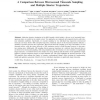Free Online Productivity Tools
i2Speak
i2Symbol
i2OCR
iTex2Img
iWeb2Print
iWeb2Shot
i2Type
iPdf2Split
iPdf2Merge
i2Bopomofo
i2Arabic
i2Style
i2Image
i2PDF
iLatex2Rtf
Sci2ools
JCC
2008
2008
Molecular simulation of multistate peptide dynamics: A comparison between microsecond timescale sampling and multiple shorter tr
Abstract: Molecular dynamics simulations of the RN24 peptide, which includes a diverse set of structurally heterogeneous states, are carried out in explicit solvent. Two approaches are employed and compared directly under identical simulation conditions. Specifically, we examine sampling by two individual long trajectories (microsecond timescale) and many shorter (MS) uncoupled trajectories. Statistical analysis of the structural properties indicates a qualitative agreement between these approaches. Microsecond timescale sampling gives large uncertainties on most structural metrics, while the shorter timescale of MS simulations results in slight structural memory for beta-structure starting states. Additionally, MS sampling detects numerous transitions on a relatively short timescale that are not observed in microsecond sampling, while long simulations allow for detection of a few transitions on significantly longer timescales. A correlation between the complex free energy landscape an...
| Added | 13 Dec 2010 |
| Updated | 13 Dec 2010 |
| Type | Journal |
| Year | 2008 |
| Where | JCC |
| Authors | Luca Monticelli, Eric J. Sorin, D. Peter Tieleman, Vijay S. Pande, Giorgio Colombo |
Comments (0)

